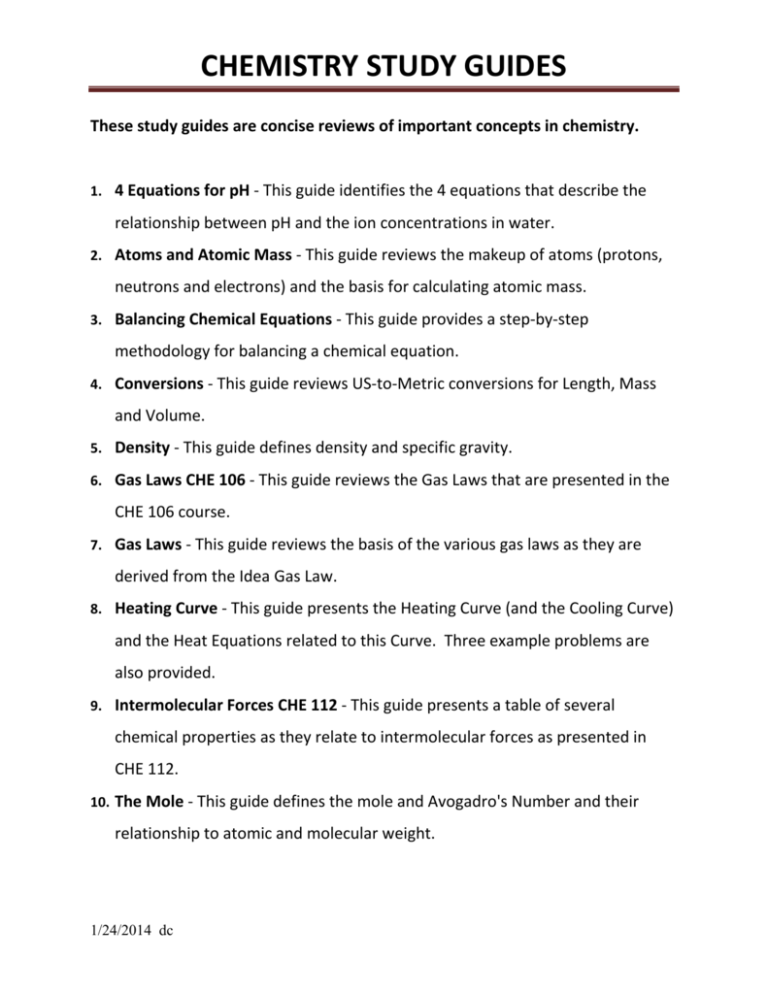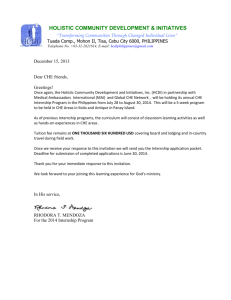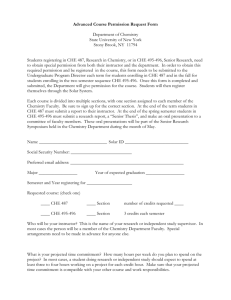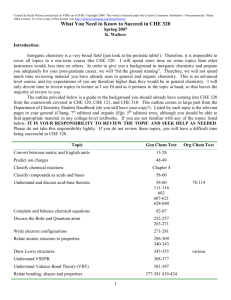CHEMISTRY STUDY GUIDES
advertisement

CHEMISTRY STUDY GUIDES These study guides are concise reviews of important concepts in chemistry. 1. 4 Equations for pH - This guide identifies the 4 equations that describe the relationship between pH and the ion concentrations in water. 2. Atoms and Atomic Mass - This guide reviews the makeup of atoms (protons, neutrons and electrons) and the basis for calculating atomic mass. 3. Balancing Chemical Equations - This guide provides a step-by-step methodology for balancing a chemical equation. 4. Conversions - This guide reviews US-to-Metric conversions for Length, Mass and Volume. 5. Density - This guide defines density and specific gravity. 6. Gas Laws CHE 106 - This guide reviews the Gas Laws that are presented in the CHE 106 course. 7. Gas Laws - This guide reviews the basis of the various gas laws as they are derived from the Idea Gas Law. 8. Heating Curve - This guide presents the Heating Curve (and the Cooling Curve) and the Heat Equations related to this Curve. Three example problems are also provided. 9. Intermolecular Forces CHE 112 - This guide presents a table of several chemical properties as they relate to intermolecular forces as presented in CHE 112. 10. The Mole - This guide defines the mole and Avogadro's Number and their relationship to atomic and molecular weight. 1/24/2014 dc CHEMISTRY STUDY GUIDES 11. Molecular Geometry - This guide describes the molecular geometries present for molecules with 2 - 5 atoms and their relationship to electron configuration, bonding and lone pairs. 12. Naming Acids - This guide provides a simple chart that reviews the naming convention for Acids. 13. Naming Ionic and Covalent Compounds - This guide reviews the naming convention for Ionic and Covalent compounds. 14. Naming Organic Compounds CHE 106 - This guide reviews the naming convention for the organic compounds presented in the CHE 106 course. 15. Organic Reactions Chapters 10 & 11 CHE 106 - This guide reviews the organic reactions presented in chapters 10 & 11 of the CHE 106 course. 16. Organic Reactions Chapters 12 CHE 106 - This guide reviews the organic reactions presented in chapter 12 of the CHE 106 course. 17. Osmosis - This guide reviews the process of osmosis and its' relationship to biological cells. 18. Periodic Trends - This guide presents the periodic trends for atomic size, ionization energy, metallic character and valence electrons. 19. pH, Acids and Bases - This guide defines the ion product constant of water, pH, the pH scale, acids and bases. 20. Polyatomic Ions - This guide lists common polyatomic ions. 21. Problem Solving - This guide presents a simple methodology useful for solving typical math and chemistry word problems. 22. Scientific Notation Rules - This guide presents the rules for converting numbers into scientific notation. 1/24/2014 dc CHEMISTRY STUDY GUIDES 23. Significant Figures - This guide reviews the rules for applying significant figures in math computations. 24. Solutions - This guide reviews 4 ways to express concentration: mass percent; volume percent; mass/volume percent and molarity. It also introduces the calculations needed for dilutions. 25. Specific Heat - This guide defines specific heat and its' role in the heat equation. 26. Standard Reaction Chapter 5 CHE 106 - This guide reviews the chemical reactions presented in chapter 5 of the CHE 106 course. 27. Temperature - This guide reviews the 3 common units for temperature: Fahrenheit; Celsius and Kelvin. 28. Typical Ionic Charges - This guide presents the typical ionic charges for elements in a periodic table format. 29. Vapor Pressure CHE 112 - This guide reviews the definition of vapor pressure and its relationship to temperature as presented in CHE 112. 30. VSEPR Theory - This guide summarizes the valence-shell electron-pair repulsion (VSEPR) Theory. 1/24/2014 dc




